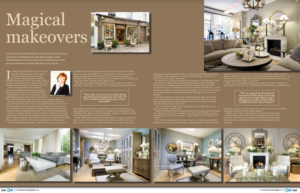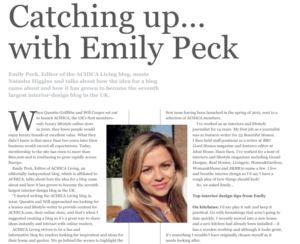Natasha Higgins on the Limehouse Basin, once the Regent’s Canal Dock, which brought exotic cargo from all over the world but now home to many of those working in the City and Canary Wharf.
Ships unloading timber from the Baltics, rice from the Far East and ice from Norway were once the daily goings-on at the Regent’s Canal Dock – a former trading port known as ‘Limehouse Basin’ today.
Down the road from the Basin on Newell Street was Charles Dickens’s Godfather’s salemaking business – shipbuilding and ship-chandling were big industries in Limehouse at the time and Charles Dickens knew the area well. He refers to ‘The Grapes’, a pub on Narrow Street in his novel Our Mutual Friend and describes the opium dens prevalent with Chinese sailors in Limehouse and across the East End in The Mystery of Edwin Drood.
The Regent’s Dock Canal eventually closed to all commercial traffic in 1969. The real turning point for London’s docks, however, was in the 1980s with the redevelopment of the Isle of Dogs. The rest of the Docklands area soon followed suite and this previously derelict part of London underwent a huge regeneration project for new offices, new homes and general attractions.
Limehouse_area_1207_DLimehouse, a name which comes from the lime kilns in the area in the 14th century, is popular today, among those working in the financial industries across the City and Docklands. It is also a place to enjoy the fantastic array of boats, scenery and great pubs and restaurants overlooking the water.
“The most desirable residential road in Limehouse is Narrow street,” says Alasdair Carpenter, Company Director of Lourdes Estate Agents. “This is predominantly because one side of the road backs directly on to the Thames and the street has lots of history, character and features some original warehouses and wharfs”.
Sebastian Sookermany, Sales Manager at Hurford-Salvi-Carr, says the river facing flats on Narrow Street achieve between “£550,000 and £650,000 for two beds in a good block. Many blocks were built in the last ten to 20 years and tend to be secure with balconies or terraces and riverside or basin views”.
James Bearryman, director of Franklyn James explains that there are three main features synonymous with Limehouse’s style of architecture – space, light and open plan living. There are many dramatic apartments particularly in the Narrow Street cul-de-sac designed by eminent architect Rae Hoffenberg.
The majority of buyers in Limehouse are affluent professionals and couples who work either in the City or Canary Wharf as the DLR gets you into both areas in less than ten minutes. Those buying in the Limehouse area are usually also rental investors and owner occupiers.
Although Limehouse has gone up in value in recent years, Carpenter says there are still pockets of ex- local authority housing that represent tremendous value and are becoming increasingly popular with buy to let investors and first time purchasers: “One such example is Barleycorn Way located just off Narrow Street,” says Carpenter.
“I have been selling property in the area for over a decade and Limehouse has, during my time, been one of the most desirable addresses in Docklands,” Carpenter adds.
James Bearryman, director of Franklyn James says that another part of east London that is showing rapid signs of growth is the Bow area: “this is possibly because it links the Docklands/Limehouse with the ever popular Victoria Park area. Ultimately, anywhere on the DLR and close to the water (river, marina, canal) should always be a very solid investment due to the ever increasing demand”.
Thinking of moving to Limehouse? Here’s an idea of what’s around…
At 44 Narrow Street is Gordon Ramsay’s pub, The Narrow, which offers traditional British pub food in a stunning location directly alongside the Thames. On a sunny day it’s an almost unbeatable spot. There is a good size outdoor area with large tables at which to sit with trendy Londoners. Large jugs of pimms or a pint of ale or cider seem to be the order of the day.
Alternatively, there is indoor seating in the bar area or the restaurant where one can enjoy the likes of beer-battered hake and chips or pan fried Gressingham duck breast, crispy heart and broccoli. The interior is tastefully designed with original fireplaces and black and white photographs on the wall detailing the rich history of the area.
Further along Narrow street at number 76 is another great pub: The Grapes. Partly owned by Sir Ian McKellen, a local resident in the area, this establishment has become something of a Limehouse institution and has a fair few strings to its bow – it survived the Blitz and was a favourite drinking hole of Dickens’s.
Upon entering the pub is the bar area which backs onto the Thames and has a small outdoor decked area giving the impression of being on a ship. On the first floor is a small yet cosy dining room with panoramic views overlooking the river towards Canary Wharf. The whole roasted Sea Bass with Lemon & Parsley Butter comes highly recommended!
Along Narrow Street is also one of the earliest rows of Georgian terraced houses which wasn’t destroyed during the war and remains well preserved. These houses are unique in that the windows are not set back from the brick frontage which is typical of later Georgian buildings.
On Newell Steet is St Anne’s Limehouse church – worth visiting if you’re in the area. This Anglican Church was built between 1714 and 1727 and is named after Queen Anne. Its clock is the highest church clock in London and it chimes every hour. In the 1970s the church was under threat of being declared derelict but in 1976 it became the centre of a vibrant church community.
Finally, Limehouse is also home to an excellent curry house: Veranda Bar and Indian Restaurant which serves a fusion of Indian, Bangladeshi and Pakistani cuisine. The restaurant itself stretches onto a large outdoor terrace overlooking Narrow Street – great for warm evenings! If we ever get any…


